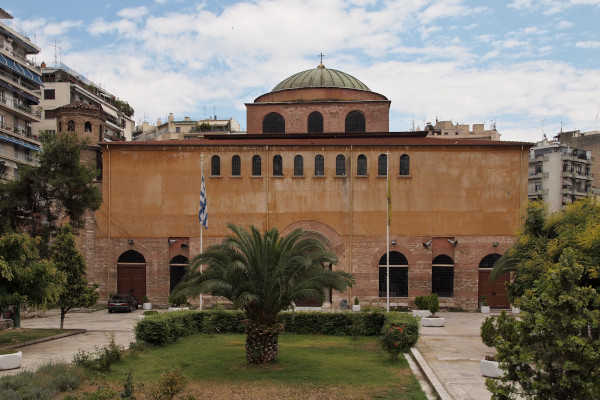What is the Hagia Sophia of Thessaloniki?
If history was your favorite subject, Hagia Sophia will appeal to you. A piece of living history, this ancient church is still in use. Attending a mass in this church that has been hearing prayers for more than 1300 years would undoubtedly be an unforgettable experience.
One of Thessaloniki’s oldest churches, the Church of God’s Wisdom, Tis Tou Theou Sophias in Greek, is a Dome Basilica. Its architectural style soon became the Eastern Roman Empire’s favorite.
A brief history
UNESCO includes the church in its list of World Heritage Sites to recognize Hagia Sophia’s historical and cultural value.
The Eastern Romans built Agia Sophia around 660 on the ruins of an early Christian Basilica destroyed by an earthquake in 620.
The church withstood damage taken in the 1185 occupation. Normans destroyed part of the city and massacred at least 7000 Thessalonians.
A few years later, in 1204, the 4th Crusade conquered Thessalonica and turned Hagia Sophia into a Catholic church. Twenty years later, the nearby Orthodox Kingdom of Epirus ousted the Latins and returned Hagia Sophia to the Orthodox Church.
In 1430, the Ottoman Turks conquered the city, and in 1523, they turned Hagia Sophia into a mosque.
Thessaloniki was liberated in 1912, and the church was changed again into a Greek Orthodox Church.
What is interesting about it?
In time, several generations decorated Hagia Sophia with hagiography.
When you look at the church’s arch, the mosaics are purely decorative without icons (images) of Saints or Jesus. They were made by Iconoclasts, a religious movement that started in 726, and advocated that depicting God and the divine hierarchy in art was blasphemous. They also made the mosaic of a cross that you cannot miss once inside the church. These people lost in 787 to the Iconolaters, those advocating that depicting God was okay. Right away after their victory, in 787, they started constructing the giant mosaic of Mother Mary that is still in place. It took the artists about ten years to finish it.
In 1890, the building, now a mosque, was destroyed by fire. The restorations uncovered a 9th century Jesus Ascension mosaic on the dome. It turned out that earlier Ottomans had plastered it as the church became a mosque centuries earlier. Similarly, mosaics have been uncovered in restorations in Hagia Sophia of Constantinople, today Istanbul.
Most Saints mosaics date back to the 10th and 11th centuries.
It is not only hagiography, however. In the church’s yard, there is a 3rd-century baptistery. You can also visit the church catacombs, though you won’t find any bones here.
It seems that every time there’s a need for restorations, Hagia Sophia reveals its secrets. In 1978, the great Thessaloniki earthquake damaged the church. The ensuing works unearthed the tomb of St Basil. He was Thessalonica’s Bishop from 904 until his death. His sarcophagus is inside the church.
You can also find a shrine to St Anne, Mother Mary’s mother. It is decorated with hagiography in which you recognize St Anne holding a young girl, Mother Mary, in her arms.
What about a mass in Hagia Sophia of Thessaloniki?
Like every other Greek church, Hagia Sophia is open to everyone regardless of religious background. If you are not Orthodox Christian, just follow what others do. For instance, there’s a moment of silence and kneeling in the Sunday mass.
If you are non-Christian, meaning Muslim, Buddhist, or other, or you just want to attend but not participate, you can stand on the side close to a wall and if people kneel, just lower your head.
Let the Byzantine Chant work on you.
